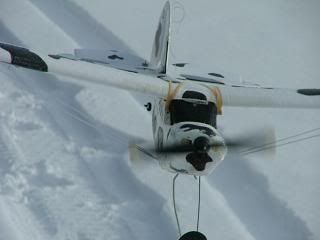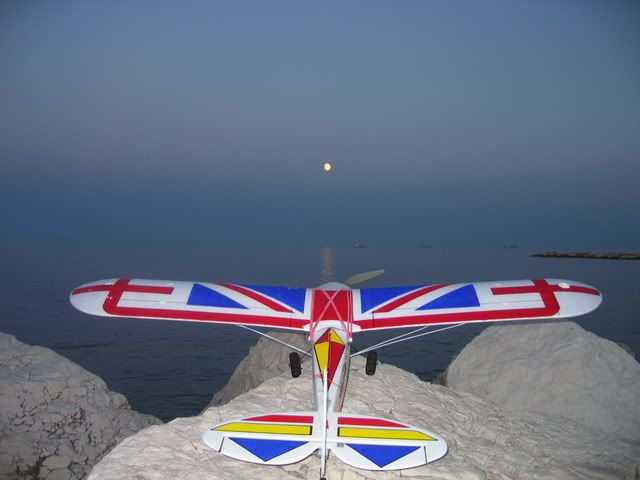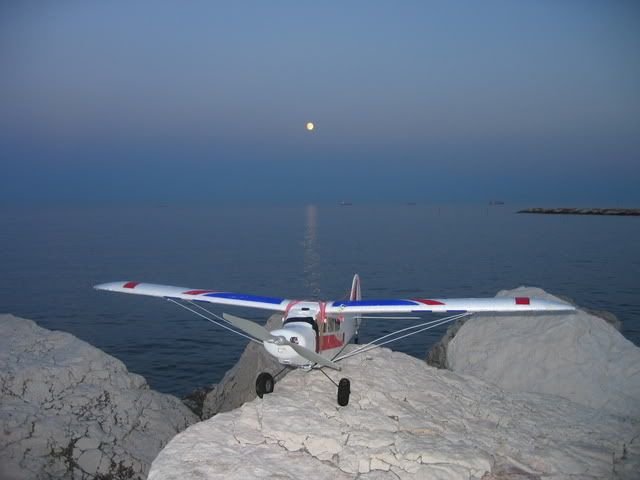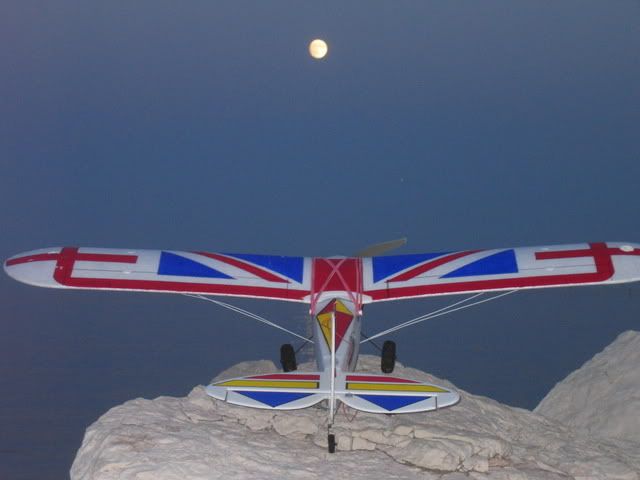Post by 60buick on Mar 24, 2007 5:19:02 GMT 1
Night flying is not for the timid unless you cover the plane in lights like a christmas tree. I have learned some rules to night flying that make it very simple to keep oriantation and it is now as relaxing as day flying untill time to land.
#1 start at sunset. It lets your eyes adjust to the lighting conditions. If you chose not too make sure you are in the dark for about 15 minutes prior to flight. It lets the "rods" in your eyes "wake up". the rods are the most light sensitive part of the eye. This is something required to fly actual aircraft at night.
#2 never take your eyes off the plane for any reason.
#3 You need minimum of 5 lights. visable from the top, bottom, front and back.
red on the left wing tip, green on the right wing tip and a white on the top of the rudder
a flashing light on the belly so you can tell if you are looking at the top or bottom of the plane
landing lights that face forward. The best place for them is in the leading edge of the wing. when turning they tell you when you can start leveling the wings and when they are level because one of the wing tip lights will go out of view.
#4 fly about 50 feet up. That way you can see both wingtip lights from the bottom when looking at the side of the plane. If you get to high you will lose all oriantation and if you get to low you only have 2 lights of reference and you can't tell if your wings are level.
#5 when turning bank steep enough so the light on the wing farthest from you is visable other wise you will lose oriantation. start leveling the wings when you see the landing lights not before or you will lose oriantation when the light on the farther wing goes out of view.
#6 fly a steady pattern. Don't get fancy. Remember you can't see the plane just little dots. If you try a loop and get confused you might as well set the transmitter down and get a broom ready. Think scale flight until you are very confident in the dark. I fly in circles around myself at about 50 feet up. The red wingtip is always closest to me and I never have less than 3 lights of reference when I fly. I know I should see the red, green, rudder and flashing light when flying away from myself until I go to turn. I then bank untill I see the rudder light and both wing lights. I hold the bank until the landing lights come into view and then I level the wings. I am them focused on the wing lights, landing lights and flashing light untill I am flying away from myself again. Then the cycle starts over.
#7 Stand close to where you are going to land so you can judge the ground distance to your planes fragile landing gear unless you have a lighted runway like a parking lot. Other wise have a big open area and set it down close to you.
#8 Land early. You don't want the LVC to force you to land someplace you can't see. I usually get 10-12 minutes so I land after 8 at night.
Now lets see some more cubs that pierce the night.
#1 start at sunset. It lets your eyes adjust to the lighting conditions. If you chose not too make sure you are in the dark for about 15 minutes prior to flight. It lets the "rods" in your eyes "wake up". the rods are the most light sensitive part of the eye. This is something required to fly actual aircraft at night.
#2 never take your eyes off the plane for any reason.
#3 You need minimum of 5 lights. visable from the top, bottom, front and back.
red on the left wing tip, green on the right wing tip and a white on the top of the rudder
a flashing light on the belly so you can tell if you are looking at the top or bottom of the plane
landing lights that face forward. The best place for them is in the leading edge of the wing. when turning they tell you when you can start leveling the wings and when they are level because one of the wing tip lights will go out of view.
#4 fly about 50 feet up. That way you can see both wingtip lights from the bottom when looking at the side of the plane. If you get to high you will lose all oriantation and if you get to low you only have 2 lights of reference and you can't tell if your wings are level.
#5 when turning bank steep enough so the light on the wing farthest from you is visable other wise you will lose oriantation. start leveling the wings when you see the landing lights not before or you will lose oriantation when the light on the farther wing goes out of view.
#6 fly a steady pattern. Don't get fancy. Remember you can't see the plane just little dots. If you try a loop and get confused you might as well set the transmitter down and get a broom ready. Think scale flight until you are very confident in the dark. I fly in circles around myself at about 50 feet up. The red wingtip is always closest to me and I never have less than 3 lights of reference when I fly. I know I should see the red, green, rudder and flashing light when flying away from myself until I go to turn. I then bank untill I see the rudder light and both wing lights. I hold the bank until the landing lights come into view and then I level the wings. I am them focused on the wing lights, landing lights and flashing light untill I am flying away from myself again. Then the cycle starts over.
#7 Stand close to where you are going to land so you can judge the ground distance to your planes fragile landing gear unless you have a lighted runway like a parking lot. Other wise have a big open area and set it down close to you.
#8 Land early. You don't want the LVC to force you to land someplace you can't see. I usually get 10-12 minutes so I land after 8 at night.
Now lets see some more cubs that pierce the night.








 in the "Position lights" thread.
in the "Position lights" thread.







 i don't think I'd have the nerve to fly at night...
i don't think I'd have the nerve to fly at night...